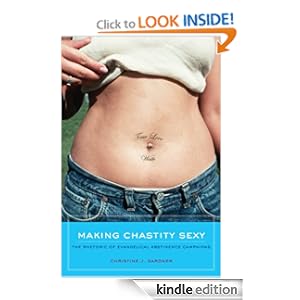Sex Talks

by Elesha Coffman
As noted in Carol Faulkner’s post on American History Now, John McGreevy named “religion and sexuality” as a neglected research topic. I don’t have a broad enough knowledge of scholarly trends to affirm or question this judgment, but sexuality certainly hasn’t been a neglected topic at Princeton University this week. By coincidence, two scholars visited campus to discuss new work on religion and sexuality, and while the presentations were quite different, they both reflected a combination of concerns that have become pervasive in the field—the linguistic turn and attention to religious practice.
On Monday Christy Gardner, associate professor of communication at Wheaton College, gave a public lecture (sponsored by the Center for the Study of Religion) on her new book Making Chastity Sexy: The Rhetoric of Evangelical Abstinence Campaigns. Her central argument was that evangelicals gained traction for their abstinence message, which is preached at flashy events sponsored by parachurch organizations including True Love Waits, Silver Ring Thing, and Pure Freedom, by shifting from negative to positive rhetoric. Out: The “just say no” approach, accompanied by nit-picky lists of what the abstinent may not do. In: A creative appropriation of feminist ideas, promoting chastity as an empowering choice for young men and women, a way to reclaim control over their bodies in defiance of an MTV culture that insists teens are helpless slaves to hormones. Alongside this analysis of why abstinence rhetoric works (though the programs don’t always work, delaying sexual debut for some teens some of the time), Gardner provided comparisons with evangelical abstinence programs in Africa. In that context there is less emphasis on personal empowerment, largely because Africans do not experience their lives as a succession of free choices.
On Thursday Bruce Dorsey, chair of the history department at Swarthmore College, visited the religion department’s weekly American Religion workshop to share insights from his works in progress on two sex scandals in the 1830s, both involving evangelical clergymen. In 1833, in what was at that point the longest trial in American history, an itinerant Methodist minister named Ephraim K. Avery stood accused of impregnating and then murdering mill worker and fellow Methodist Maria Cornell. He was eventually acquitted, but this verdict, like so many others in high-profile cases, stirred rather than settled debate. In 1835 a Christian Connection revivalist named Eleazer Sherman was tried in an ecclesial court for making sexual advances to young men. Sherman was unapologetic, casting his actions as examples of Christian brotherhood, but the other ministers involved hastened to discredit his ministry and distance themselves from him as much as possible. Dorsey interpreted these scandals as evidence of shifting cultures of work, gossip, gender, and sexuality in the new republic. At a time of so much mobility, with so much in flux, scandals marked the collision of different sets of expectations. The fallout from those collisions radiated in all directions as people newly connected by print and popular culture attempted to make sense of what happened.
Though both presentations attended to religious leaders—albeit entrepreneurial ones whose success owed little to credentials or formal, institutional support—Gardner and Dorsey followed the “lived religion” track in focusing on ways religious ideas play out in the everyday. What’s it like to sit in a strobe-lighted room full of teenagers yelling, “Sex is great”? How does this make sense to them? Or, what sorts of behaviors occurred when nineteenth-century revival preachers shared close quarters on the road? If different men perceived the same behaviors very differently, as in the Sherman case, why?
The more striking commonality between the presentations, to me, was their concentration on rhetoric and narrative. (Granted, Gardner is a rhetorician, not a historian, but I didn’t find her presentation that different from something I might hear at AAR or ASCH, so for the purposes of this discussion I’ll count her as one of us. I hope she doesn’t mind.) In response to expected questions from the audience, Gardner was able to give statistics on the abstinence programs, but her real interest was how people talked about sexuality—at rallies, in testimonies, in small groups, in Africa. Similarly, while Dorsey has spent enough time with the literature of the Avery case to form definite conclusions regarding who did what to whom, he was more interested in storytelling, especially the blurry line between Christian confession and gossip. When was a tale of sexual misbehavior evidence of contrition to nineteenth-century evangelicals, and when was it grounds for ostracism, even prosecution? Misreading that distinction could be extremely dangerous.
Perhaps now that attention to practice (including, often, deviant practice) and language has become widespread in the field, a surge of scholarship on religion and sexuality is on its way. I might get to test that hypothesis next week, when the CSR, Princeton Theological Seminary, and the Center of Theological Inquiry sponsor a conference on the 400th anniversary of the King James Bible. Goodness knows there’s plenty of racy stuff in there.

Comments
I promise on my promise ring that I won't comment again. Great post!!!